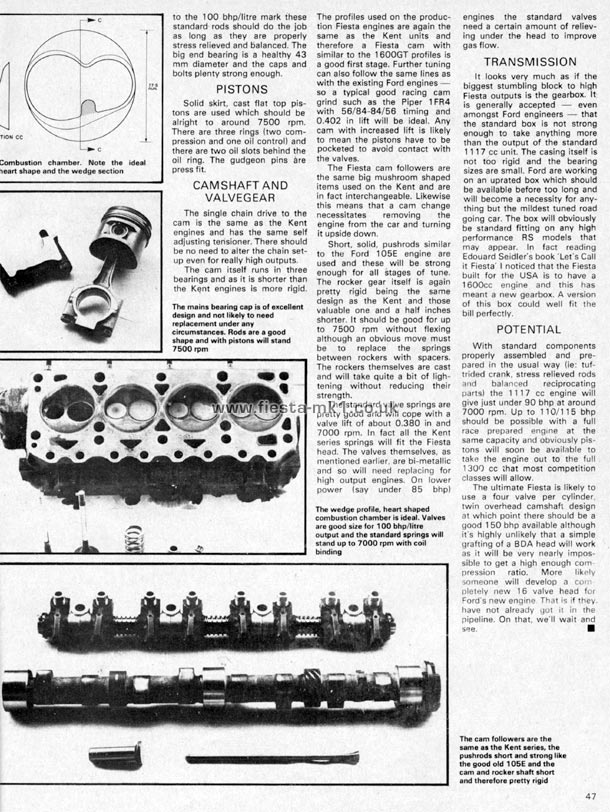Copy of Article Text Below
.....to the 100 bhp/litre mark these standard rods should do the job as long as they are properly stress relieved and balanced. The big end bearing is a healthy 43 mm diameter and the caps and bolts plenty strong enough.
PISTONS
Solid skirt, cast flat top pistons are used which should be alright to around 7500 rpm. There are three rings (two compression and one oil control) and there are two oil slots behind the oil ring. The gudgeon pins are press fit.
CAMSHAFT AND VALVEGEAR
The single chain drive to the cam is the same as the Kent engines and has the same self adjusting tensioner. There should be no need to alter the chain setup even for really high outputs.
The cam itself runs in three bearings and as it is shorter than the Kent engines is more rigid. The profiles used on the production Fiesta engines are again the same as the Kent units and therefore a Fiesta cam with similar to the 1600GT profiles is a good first stage. Further tuning can also follow the same lines as with the existing Ford engines - so a typical good racing cam grind such as the Piper 1FR4 with 56/84-84/56 timing and 0.402 in lift will be ideal. Any cam with increased lift is likely to mean the pistons have to be pocketed to avoid contact with the valves.
The Fiesta cam followers are the same big mushroom shaped items used on the Kent and are in fact interchangeable. Likewise this means that a cam change necessitates removing the engine from the car and turning it upside down.
Short, solid, pushrods similar to the Ford 105E engine are used and these will be strong enough for all stages of tune. The rocker gear itself is again pretty rigid being the same design as the Kent and those valuable one and a half inches shorter. It should be good for up to 7500 rpm without flexing although an obvious move must be to replace the springs between rockers with spacers. The rockers themselves are cast and will take quite a bit of lightening without reducing their strength.
The standard valve springs are pretty good and will cope with a valve lift of about 0.380 in and 7000 rpm. In fact all the Kent series springs will fit the Fiesta head. The valves themselves, as mentioned earlier, are bi-metallic and so will need replacing for high output engines. On lower power (say under 85 bhp) engines the standard valves need a certain amount of relieving under the head to improve gas flow.
TRANSMISSION
It looks very much as if the biggest stumbling block to high Fiesta outputs is the gearbox. It is generally accepted -- even amongst Ford engineers - that the standard box is not strong enough to take anything more than the output of the standard 1117 cc unit. The casing itself is not too rigid and the bearing sizes are small. Ford are working on an uprated box which should be available before too long and will become a necessity for anything but the mildest tuned road going car. The box will obviously be standard fitting on any high performance RS models that may appear. In fact reading Edouard Seidler's book 'Let's Call it Fiesta' I noticed that the Fiesta built for the USA is to have a 1600cc engine and this has meant a new gearbox. A version of this box could well fit the bill perfectly.
POTENTIAL
With standard components properly assembled and prepared in the usual way (ie: tuf-trided crank, stress relieved rods and balanced reciprocating parts) the 1117 cc engine will give just under 90 bhp at around 7000 rpm. Up to 110/115 bhp should be possible with a full race prepared engine at the same capacity and obviously pistons will soon be available to take the engine out to the full 1300 cc that most competition classes will allow.
The ultimate Fiesta is likely to use a four valve per cylinder, twin overhead camshaft design at which point there should be a good 150 bhp available although it's highly unlikely that a simple grafting of a BDA head will work as it will be very nearly impossible to get a high enough compression ratio. More likely someone will develop a completely new 16 valve head for Ford's new engine That is if they, have not already got it in the pipeline. On that, we'll wait and see.
Captions -
Top-Left - Combustion chamber. Note the ideal heart shape and the wedge section
Middle-Left - The mains bearing cap is of excellent design and not likely to need replacement under any circumstances. Rods are a good shape and with pistons will stand 7500 rpm
Middle-Right - The wedge profile, heart shaped combustion chamber is ideal. Valves are good size for 100 bhp litre output and the standard springs will stand up to 7000 rpm with coil binding
Bottom-Right - The cam followers are the same as the Kent series, the pushrods short and strong like the good old 105E and the cam and rocker shaft short and therefore pretty rigid
|




